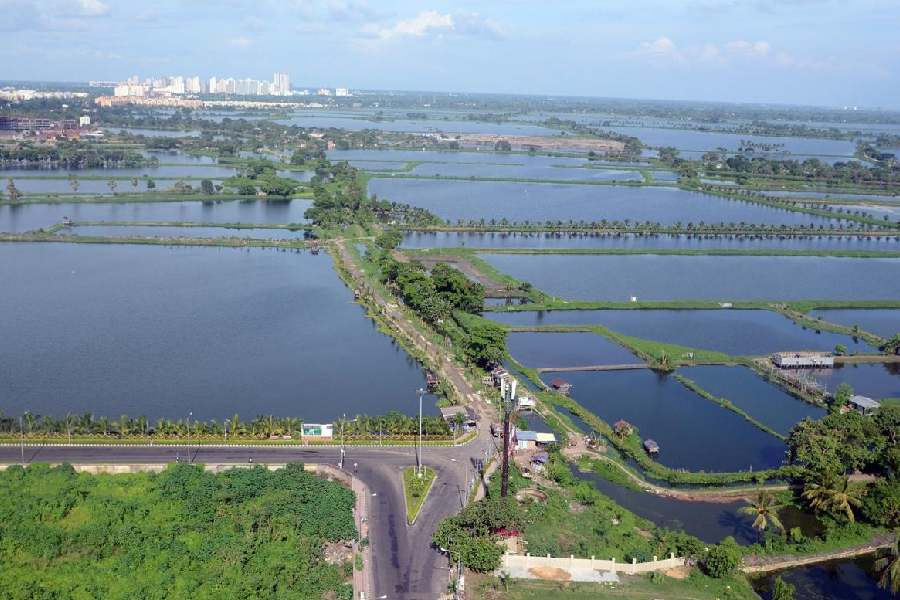 |
| Rampant deforestation has taken a toll on the ecology of the region. Picture by Eastern Projections |
This year, World Environment Day, June 5, fell on a Sunday. Since at least three states, Nagaland, Mizoram and Meghalaya are predominantly Christian in character, hopefully church-goers spared a thought for the depleting forest cover in the region and uttered a prayer on behalf of the environment. As per the 1997 statistics, the recorded forest area in the northeastern region is 2,75,510 square km, as against the all-India figure of 15, 30,420 square km. The region supports 18 per cent of the country?s forest cover. Northeast India has rain forests, a couple of national parks and game sanctuaries and is, according to scientists, a bio-diversity hot spot. Medicinal herbs abound in every state of the region and these are only recently in the process of being documented.
In terms of recorded forests, Mizoram ranks the highest with 75.59 per cent which is a commendable figure, considering that the state has a total geographical area of only 21,081 square km. Actual forest cover in Mizoram is as high as 89.06 per cent of the geographical area. In Nagaland the recorded forest is 52.04 per cent of the geographical area whereas the actual forest cover is 85.78 per cent. Arunachal Pradesh has a geographical area of 83,743 square km and a recorded forest area of 61.54 per cent which is very poor indeed. Arunachal?s actual forest cover is 81.92 per cent of the geographical area. This includes the lush green Namdapha wildlife sanctuary which is still in its pristine state. Perhaps the state with the lowest recorded forest area and actual forest cover is Assam. Whereas, Assam?s geographical area is 78,438 square km its recorded forest area is a mere 30,708 square km which is just 39.15 per cent of the total area. Actual forest cover in Assam is a mere 30.4 per cent. Most of Assam?s forests are located in Karbi Anglong, North Cachar Hills and Kokrajhar districts which also happen to be the conflict zones of today.
According to the Forest Survey of India, Dehra Dun, there has been a drastic change in the forest cover of the region between 1995 and 1997. The highest percentage of negative change in forest cover is in Assam, which has gone down by 237 followed by Manipur, which shows a negative trend of 140. Only two states, Mizoram and Tripura have shown a positive gain of 199 and 8 respectively. On the whole, the northeastern region barring Sikkim is on a negative shortfall of 316.
One hopes that this alarming trend of loss of forest cover has been arrested by the Supreme Court regulation of 1996. But even then there is not much cause for optimism. In Meghalaya, recently, a timber mafia was caught red-handed taking away freshly cut logs from a forest which is just 10 km away from the head office of the state forest department in Shillong. The area in question happens to be a watershed and a virtual life support system for lakhs of people residing in Shillong who draw their supply of water from some of the perennial water sources located around the reserve forest area. A senior forest department official says that sections of the law pertaining to timber theft from reserved forests are all but punitive. A person who is caught felling a tree within any reserve forest is given a stern warning not to repeat his act and is made to pay a simple fine of Rs 200.
This year, the theme for observing World Environment Day is Green Cities: Plan for the Planet. Such themes sound very grand as slogans but their implementation is an extremely challenging task. Green Cities is a direct challenge to every urban dweller to have a green space within his compound. Cities are not made up only of community parks and public spaces. They comprise every single unit inhabited by a family living within a particular city. The question is whether individuals care about having a green space or whether they are actually in pursuit of a dream for building up every available space with concrete structures, sometimes even encroaching upon public roads and property.
India faces a terrible challenge from climate change which can have a cataclysmic effect. Guwahati is today grappling with mercury that is soaring upwards and does not promise to come down so easily. Even Shillong the much-celebrated hill station has lost its pride as a destination with a salubrious climate. Climate changes are bound to happen with so many concrete structures replacing the climatically sustainable Assam-type architecture. There was a time when every house in Shillong had at least one lemon tree and a couple of orange trees. It was a beautiful sight to behold when the tree would be filled with yellow fruit. Now lemon trees are hardly seen. The famous Khasi lemon with its inimitable fragrance is not such a common sight any more. Yet no one feels the pain of losing one?s green space.
In the absence of strict building rules, Meghalaya is turning into an urban slum. This is one state that does not believe in demarcating residential areas from commercial ones. As a result, every residence which faces the main road today has a shop extension in front which replaces the lawn and compound with a flower garden and some fruit trees. In fact green space is at a premium today. People in this state have been brainwashed to believe that money is more valuable than fresh air, clean water and breathing space.
Trees are carbon sinks which support our lifecycle. Thankfully the forest department has acquired reserved forests which act as natural water reservoirs and a green lung for the people of Shillong.
Meghalaya is a tribal state where only four per cent of forests belongs to the state. The rest are with communities, clans and individuals. Land belongs to the people, not to the state. Hence any legislation pertaining to increase in green cover and implementation of community forestry schemes must have the cooperation of people in order to succeed. Yet what is appalling is that there is no sense of stake-holdership in community land. People seem to think that everybody?s land is nobody?s land. Hence nobody feels responsible for planting trees after old ones are cut down. Meghalaya boasts of its sacred groves which have actually stood the test of time and are still surviving like little oases in the midst of barren land. Unfortunately, the Khasis have failed to narrate to their younger generation the philosophy and scientific wisdom behind the sacred groves, which is a valuable legacy left behind by their forefathers. Today the sacred groves have become only a tourist attraction.
The UN statistics on urbanisation is indeed disquieting. It says nearly 60 per cent of the world?s population will live in cities by 2030, that cities consume 75 per cent of the planet?s natural resources and discharge 75 per cent of waste. Approximately two million children under five die each year from acute respiratory infections caused by vehicles and factory fumes. In Shillong, recently the State Bank of India gave out 53 car loans in one single day. While roads have not expanded, the number of vehicles is staggering. Yet Shillongites have not even considered the idea of pooling vehicles for dropping schoolchildren. Shillong?s elite schools do not practice the system of using schoolbuses for picking up and dropping children to and from school. This could have reduced the number of vehicles on the roads in the morning and evening.
Concerned citizens never fail to discuss the load of pollution and the garbage disposal system privately but they are yet to come out with an action plan. However, I believe that community efforts can only be successful if individual efforts are visible. Today we all preach about poor garbage disposal systems but do not refrain from throwing garbage in the nearest drain ourselves. This is where government initiatives fail.
Personal responsibility for the environment can alone bring about a sea change. We could begin by growing a tree and looking after it until it is able to care for itself. If each household in Shillong, Guwahati, Imphal, Itanagar, Aizawl, Agartala and Kohima grew a sapling each on any day this month, I am sure the planet will be a healthier place to live in.










